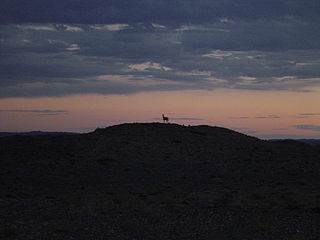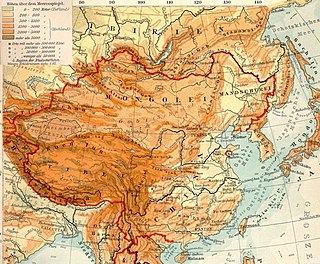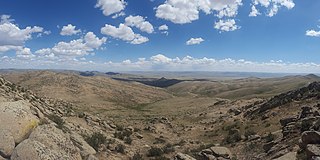Related Research Articles

Przewalski's horse, also called the takhi, Mongolian wild horse or Dzungarian horse, is a rare and endangered horse originally native to the steppes of Central Asia. It is named after the Russian geographer and explorer Nikolay Przhevalsky. Once extinct in the wild, since the 1990s it has been reintroduced to its native habitat in Mongolia in the Khustain Nuruu National Park, Takhin Tal Nature Reserve, and Khomiin Tal, as well as several other locales in Central Asia and Eastern Europe.

The Eastern Gobi desert steppe is a deserts and xeric shrublands ecoregion in Mongolia and northern China. It is the easternmost of the ecoregions that make up the larger Gobi Desert. It lies between the more humid Mongolian–Manchurian grassland on the north, east, and southeast, and the drier Alashan Plateau semi-desert to the west.

The Ordos Desert is a desert/steppe region in Northwest China, administered under the prefecture of Ordos City in the Inner Mongolian Autonomous Region. It extends over an area of approximately 90,650 km2 (35,000 sq mi), and comprises two sub-deserts: China's 7th-largest desert, the Kubuqi Desert, in the north; and China's 8th-largest desert, the Mu Us Desert, in the south. Wedged between the arable Hetao region to the north and the Loess Plateau to the south, the soil of the Ordos Desert is mostly a mixture of dry clay and sand, and as a result is poorly suited for agriculture.

The Bayankhongor Province or Bayanhongor Aimag is one of the 21 aimags (provinces) of Mongolia. It is located in the southwest of the country and, at 116,000 square kilometers, it is one of the largest aimags. The capital of the aimag shares the provincial name, Bayankhongor.

Zavkhan, also spelt Zaukhan or Zabhkhan, is one of the 21 aimags (provinces) of Mongolia, located in the west of the country, 1,104 km from Ulaanbaatar. Its capital is Uliastai. The aimag is named after the Zavkhan River, which forms the border between Zavkhan and Gobi-Altai aimag.

The Mongolian wild ass, also known as Mongolian khulan, is the nominate subspecies of the onager. It is found in southern Mongolia and northern China. It was previously found in eastern Kazakhstan and southern Siberia before being extirpated there through hunting. As of 2015, the Mongolian wild ass is listed as Near Threatened by the IUCN. Current population estimates are approximately 42,000 individuals in Mongolia and around 5,000 individuals in Northern China.

The Mongolian Plateau is an inland plateau in Asia that lies between 37°46′-53°08′N and 87°40′-122°15′E and has an area of approximately 3,200,000 square kilometers (1,200,000 sq mi). It is bounded by the Greater Hinggan Mountains in the east, the Yin Mountains to the south, the Altai Mountains to the west, and the Sayan and Khentii mountains to the north. The plateau includes the Gobi Desert as well as dry steppe regions. It has an elevation of roughly 1,000 to 1,500 meters, with the lowest point in Hulunbuir and the highest point in the Altai.

The Mongolian-Manchurian grassland, also known as the Mongolian-Manchurian steppe or Gobi-Manchurian steppe, in the temperate grassland biome, is an ecoregion in East Asia covering parts of Mongolia, the Chinese Autonomous region of Inner Mongolia, and Northeast China.
Bayan-Ovoo is a sum (district) of Ömnögovi Province in the Gobi Desert of southern Mongolia. The seat lies at Erdenetsogt.

Hustai National Park, located in the Khustai Mountains of Töv Province, is a national park of Mongolia. It is also known as Khustain Nuruu National Park. It covers an area of 506 km2 (195 sq mi). The Tuul River runs through the park.

The Gobi Desert is a large, cold desert and grassland region located in northern China and southern Mongolia. It is the sixth largest desert in the world. The name of the desert comes from the Mongolian word Gobi, used to refer to all of the waterless regions in the Mongolian Plateau; in Chinese, Gobi is used to refer to rocky, semi-deserts such as the Gobi itself rather than sandy deserts.
Mountain Kalamaili Ungulate Nature Reserve, also spelled Kalamely Nature Reserve, is a nature reserve in Xinjiang Autonomous Region of China, targeting in preserving the wildlife and natural vegetations in the arid steppe ecosystem. As one of the largest nature reserves in China, established in April 1982, it stretches from the Ulungur River in the north, across the heart of Dzungarian Basin, and reaches to the northern extension of Tianshan Mountains in the south, covering an area of more than 14,000 km2 (5,400 sq mi).

The Daurian Nature Reserve is a Russian zapovednik situated in the southern part of Zabaykalsky Krai in Siberia, Russia, close to the border with Mongolia. It is part of a World Heritage Site named "The Landscapes of Dauria".

The wild Bactrian camel is an endangered species of camel endemic to Northwest China and southwestern Mongolia. It is closely related but not ancestral to the domestic Bactrian camel. Genetic studies have established it as a separate species which diverged from the Bactrian camel about 0.7–1.1 million years ago.

The wildlife of Mongolia consists of flora, fauna and funga found in the harsh habitats dictated by the diverse climatic conditions found throughout the country. In the north, there are salty marshes and fresh-water sources. The centre has desert steppes. In the south, there are semi deserts as well as the hot Gobi Desert in the south, the fifth-largest desert in the world.
The Great Gobi A Strictly Protected Area is a nature reserve in the Gobi Desert, situated in the southwestern part of Mongolia at the border with China. A similar reserve in the Gobi exists farther to the west - the Great Gobi B Strictly Protected Area. Both reserves form one unit, the Great Gobi Strictly Protected Area (SPA), which encompasses a total of 53,000 km2 (20,000 sq mi). Great Gobi A is one of the last refuges for critically endangered animals such as the wild Bactrian camel and the Gobi bear.
John Neville Hare was a British explorer, author, and conservationist, known for campaigning for the preservation of the Wild Bactrian camel.

The Altai montane forest and forest steppe ecoregion covers patches of the subalpine forest belt on the Altai Mountains, crossing the border region where Russia, Kazakhstan, Mongolia and China meet. The region has high biodiversity, as it is located in transition zones between different ecoregions, altitudes, and climate zones. It is in the Palearctic realm, with a Cold semi-arid climate. It covers 35,199,998 km2 (13,590,795 sq mi).

Return of the Wild Horses is an in-situ conservation project organized by Prague Zoo. Its aim is to increase the numbers and genetic diversity of Przewalski's horses in their native habitat in Mongolia. Resuming previous similar European projects, Return of the Wild Horses transports and reintroduces captive-bred wild horses into large nature reserves in Mongolia, the project also provides material support to Mongolian rangers who protect and monitor the herds in Great Gobi B Strictly Protected Area. Through yearly transports of horses from the Czech Republic starting in 2011, Zoo Prague managed to increase the population of wild horses in Khomyn Tal by 34 animals.

The Alashan Plateau semi-desert ecoregion covers the southwestern portion of the Gobi Desert where precipitation in the mountains is sufficient for a short part of the summer to support sparse plant life. The terrain is basin and range, with elevations from 1,000 to 2,500 metres. The region straddles the China–Mongolian border, with the Tibetan Plateau to the south, and the more arid regions of the Gobi to the north and east.
References
- 1 2 3 Petra Kaczensky, Namtar Enkhsaikhan, Oyunsaikhan Ganbaatar, and Chris Walzer: The Great Gobi B Strictly Protected Area in Mongolia - refuge or sink for wolves Canis lupus in the Gobi. Wildlife Biology 14(4):444-456. 2008. doi : 10.2981/0909-6396-14.4.444